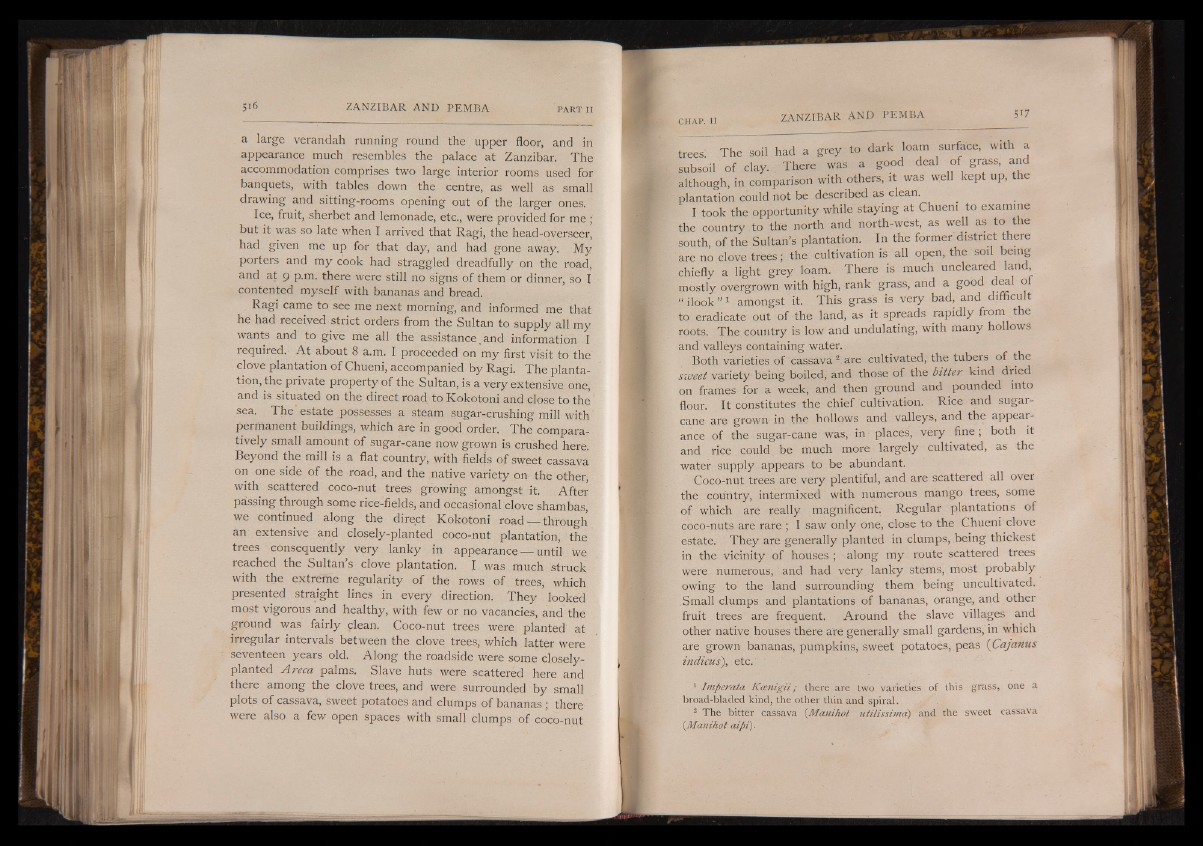
a large verandah running round the upper floor, and in
appearance much resembles the palace at Zanzibar. The
accommodation comprises two large interior rooms used for
banquets, with tables down the centre, as well as small
drawing and sitting-rooms opening out of the larger ones.
Ice, fruit, sherbet and lemonade, etc., were provided for me ;
but it was so late when I arrived that Ragi, the head-overseer,
had given me up for that day, and had gone away. My
porters and my cook had straggled dreadfully on the road,
and at 9 p.m. there were still no signs of them or dinner, so I
contented myself with bananas and bread.
Ragi came to see me next morning, and informed me that
he had received strict orders from the Sultan to supply all my
wants and to give me all the assistance. and information I
required. A t about 8 a.m. I proceeded on my first visit to the
clove plantation of Chueni, accompanied by Ragi. The plantation,
the private property of the Sultan, is a very extensive one,
and is situated on the direct road to Kokotoni and close to the
sea. The estate possesses a steam sugar-crushing mill with
permanent buildings, which are in good order. The comparatively
small amount of sugar-cane now grown is crushed here.
Beyond the mill is a flat country, with fields of sweet cassava
on one side of the road, and the native variety on the other,
with scattered coco-nut trees growing amongst it. After
passing through some rice-fields, and occasional clove shambas,
we continued along the direct Kokotoni road — through
an extensive and closely-planted coco-nut plantation, the
trees consequently very lanky in appearance— until we
reached the Sultan’s clove plantation. I was much struck
with the extreme regularity of the rows of trees, which
presented straight lines in every direction. They looked
most vigorous and healthy, with few or no vacancies, and the
ground was fairly clean. Coco-nut trees were planted at
irregular intervals between the clove trees, which latter were
seventeen years old. Along the roadside were some closely-
planted Areca palms. Slave huts were scattered here and
there among the clove trees, and were surrounded by small
plots of cassava, sweet potatoes and clumps of bananas ; there
were also a few open spaces with small clumps of coco-nut
trees’. The soil had a grey to dark loam surface, wi a
subsoil of clay. There was a good deal of grass, and
although, in comparison with others, it was well kept up, the
plantation could not be described as clean.
I took the opportunity while staying at Chueni to examine
the country to the north and north-west, as well as to the
south, of the Sultan’s plantation. In the former district there
are no clove trees; the cultivation is all open, the soil being
chiefly a light grey loam. There is much uncleared land,
mostly overgrown with high, rank grass, and a good deal of
“ ilook ” 1 amongst it. This grass is very bad, and difficult
to eradicate out of the land, as it spreads rapidly from the
roots. The country is low and undulating, with many hollows
and valleys containing water.
Both varieties, of cassava 2 are cultivated, the tubers of the
sweet variety being boiled, and those of the bitter kind dried
on frames for a week, and then ground and pounded into
flour. It constitutes the chief cultivation. Rice and sugarcane
are grown in the hollows and valleys, and the appearance
of the sugar-cane was, in places, very fine; both it
and rice could be much more largely cultivated, as the
water supply appears to be abundant.
Coco-nut trees are very plentiful, and are scattered all over
the country, intermixed with numerous mango trees, some
of which are really magnificent. Regular plantations of
coco-nuts are rare ; I saw only one, close to the Chueni clove
estate. They are generally planted in clumps, being thickest
in the vicinity of houses ; along my route scattered trees
were numerous, and had very lanky stems, most probably
owing to the land surrounding them being uncultivated.
Small clumps and plantations of bananas, orange, and other
fruit trees are frequent. Around the slave villages and
other native houses there are generally small gardens, in which
are grown bananas, pumpkins, sweet potatoes, peas (Cajanus
indicus), etc/
1 Imperata Ktmigiij there are two varieties of this grass, one a
broad-bladed kind, the other thin and spiral.
2 The bitter cassava (,Ma.nih.ot utilissimd) and the sweet cassava
(Manihot aipi).